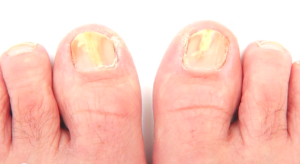 Looking for the early signs of toenail fungus?
Looking for the early signs of toenail fungus?
Distal subungual onychomycosis is the scientific name of the most common type of toe nail fungus. It’s caused by fungi known as dermatophytes. Notably, yeast and molds are also responsible for toenail fungus, which affects both the nail and the skin under the nail bed.
There are many signs of toenail fungus, depending on the type and stage of the infection.
Symptoms of Toe Fungus
During the early stage of distal subungual onychomycosis some symptoms include:
• Yellow patches or streaks under the nail bed
• Pieces of skin or nail fragments may build up under the nail. This is keratin; which is a protein that makes up the nails and skin
• The nail may exhibit some discoloration by turning yellow, brown or white
• The nail thickens into a tough layer and actually separates from the skin
• The nail may become brittle and in some cases, it breaks easily
White superficial onychomycosis is another type of fungal nail infection also caused by dermatophytes. It shows up as:
• White streaks or spots on the surface of the nail
• The nail surface will get soft and powdery once the infection worsens
With this type of infection, the nail does not separate from the skin. But the nail surface may crumble and turn brown or gray.
Other Types of Fungal Nail Infections
Candida onychomycosis: This is a nail yeast infection.
Proximal subungual onychomycosis is also a fungal nail infection. It is more common among Human Immunodeficiency Syndrom (HIV) patients.
How to Avoid Toenail Fungus
In order to avoid this infection, it is important to know situations and conditions that are likely to make you vulnerable.
• Age plays a major role in determining who is more likely to get this infection. Elderly individuals are more predisposed. You should be on the lookout for this infection as you get older.
• People with suppressed immunity are more susceptible, compared to people with strong systems. Therefore, eating foods that boost immunity will not only keep toenail fungus away.
• Other diseases such as diabetes that affect limb circulation tend to make it easy for this infection to set in. Therefore, it is good to watch for these lifestyle diseases by exercising regularly.
• Hyperhidrosis is another condition that predisposes an individual to these infections. The feet sweat excessively, creating a favorable environment for fungal infections to thrive. The best and easiest solution is wearing cotton socks that absorb the sweat or using powder to keep the feet dry.
• Wearing closed shoes for long hours every day provides a dark and moist environment. This is where all fungi thrive. You should always try to let your feet breathe from time to time.
• Having frequent fungal skin infections make you vulnerable to toe fungus. Especially if the condition is not treated effectively.
• Trauma that exposes the nail bed makes it easy for fungal infections to occur.
Therefore, avoiding foot fungus is not difficult, as there are simple things that you can do to keep it away. Apart from following the tips discussed above, you should make a habit of using antifungal shoe sprays and powders. Especially if your lifestyle requires you to wear closed shoes frequently.
This will keep your feet dry, thereby decreasing the chances of a foot fungus infection. If you have to use nail polishes or lacquers, products with antifungal ingredients will go a long way in stopping re-infection. All in all, it is always good to seek medical attention if any of the above methods do not yield any positive results.


